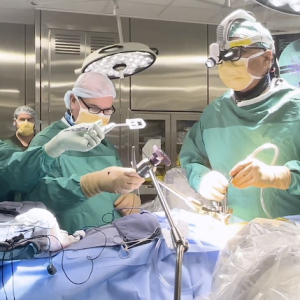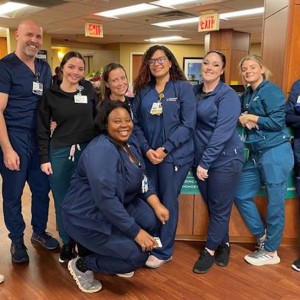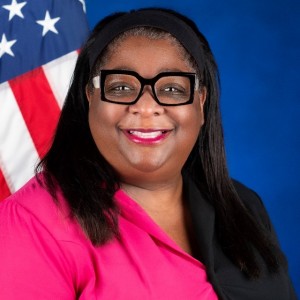What does it mean to be a board certified plastic surgeon?
David L. Mobley, M.D., Sarasota Plastic Surgery Center: There are 24 recognized boards under the American Board of Medical Specialties, and the American Board of Plastic Surgery is one of them. We want to educate people that you want to be going to people who are certified plastic surgeons through the American Board of Plastic Surgery.
James W. Marsh, M.D., James W. Marsh M.D., P.A.: Initially, to be recognized as a board-certified plastic surgeon through the American Board of Plastic Surgery, you had to first finish medical school and then you had to go to school for an additional eight to nine years before taking a series of tests and presenting case studies to the Board. At that time, cosmetic surgery was a minimal part of plastic surgery; there were a lot of other things you needed to learn, from treating head and neck cancer to microsurgery. Whereas now, when people hear the term plastic surgery they generally think of cosmetic surgery.
Scott J. Engel, M.D., Sarasota Plastic Surgery Center: There is extensive training to become a plastic surgeon, which, these days, is usually about three years of general surgery and then three years of plastic surgery.
Marsh: Legally, a doctor can open their own plastic surgery practice as soon as they get their diploma from medical school. Now, I’m not saying only proper board-certified plastic surgeons do good work; there are doctors out there who do great work in cosmetic surgery that don’t have certain credentials. However, there are others who abuse the system and can give a bad wrap to all plastic surgeons in the area. So, I believe it’s important that there is a distinction.
What are the most common procedures in cosmetic surgery?
Engel: In 2013, liposuction was the number one procedure, followed by breast augmentation. Men typically do liposuction on their love handles, face-lifts and neck lift procedures. We also see a fair amount of gynecomastia surgery for male breast developments.
Marsh: Ninety percent of the procedures that I do are for the face—eyes, nose and face-lifts. I will occasionally do arm lifts, tummy tucks and breast augmentations, but I would rather refer patients to friends of mine who enjoy doing these procedures. When you’ve done plastic surgery for a certain amount of time, you know what you like to do and you also know where your skills really shine. I’ve done 4,000 face-lifts and 5,000 eyelids, which only a handful people can say they’ve done—I enjoy it, I do a good job, and that’s what I’m known for.
How big is the demand for cosmetic surgery and non-invasive procedures in our area? What are your demographics?
Engel: There is a huge demand for plastic surgery in our area. Everyone thinks of Sarasota as having an older population, and we do see a good amount of people over the age of 50; however, we also have a lot of patients who are young. People are living longer these days and they are caring about their looks longer. We’re doing body procedures on people in their 60s. Every year our statistics show that nationally the number of plastic surgery procedures continues to rise.
Marsh: I cater to an older demographic; my average patient is 69 or 70 years old, but really, you should start doing things when you’re in your 40s. Also, when I came to town, 15 percent of my patients were men. I would say now at least 40 percent of my patients are men.
Mobley: For us, a little over 10 percent of our patients are men; it’s low compared to women, but it continues to rise. I know that nationally 9.4 percent of total plastic surgery patients are men, which has increased 273 percent since 1997.
Elizabeth Callahan, Medical Director, SkinSmart Dermatology: The demand for non-invasive cosmetic procedures is also on the rise. Based on statistics from the American Society for Dermatologic Surgery, dermatologists alone performed more than 89,000 non-invasive, cryolipolysis procedures in 2013. People are now, more than ever, interested in procedures that have little to no downtime and are willing to trade that off for more modest results that don’t involve needles and incisions.
What are some of the newest and most exciting innovations in cosmetic surgery?
Marsh: Big advances only come along about once every 8 to 10 years. Every time something new comes out it strikes everyone’s interest, but it doesn’t mean that it’s groundbreaking. The rule of thumb for plastic surgeons is when something new comes out it slowly gets refined and becomes more reliable. I always tell my patients, “don’t be the first one on the bandwagon, because it’s likely things are going to change in a year or two.” There are new and exciting things, but they are usually just tweaks to something that is already around.
Engel: A lot of television shows and magazines have actually done [more harm] than good by constantly informing people about the new advancements out there. A lot of times the answer goes back to one of the proven procedures out there like liposuction and face-lifts; it’s not as exciting, but it’s the truth.
What is the difference between a face-lift and a thread-lift?
Mobley: With a face-lift we’re partially lifting the SMAS (superficial musculoaponeurotic system), which covers the muscles of the face, and then use it as support throughout the face. Then we tighten the skin, trim away the extra and close the incisions. On the other hand, thread-lifts are an attempt to use sutures that run through the face and catch areas of tissue then run back through the face and suture the skin down. The main problem with thread-lifts is that after a couple years it appears the area that has been caught onto gives way and you lose the lifting effect. Also, because it uses sutures to tug on the skin you can get odd facial deformities from pulling on one area instead of lifting the whole face as a unit.
What about advances in skin tightening?
Marsh: It would be nice if we could get something that would tighten your skin without excising tissue. The Fraxel, a CO2 laser, was considered the gold standard of lasers. It vaporized the surface of the skin, and because it created heat, people could get skin burns from it. It got rid of wrinkles, but it could cause a loss of pigmentation, so the skin looked funny from being half skin and half scar. Next, advances in CO2 laser technology came out that, instead of removing the entire surface of skin, burned a bunch of dots in the skin that healed with collagen, which is essentially scar. Eventually it was determined that if you wanted to get good tightening results you had to go through the process used by lasers like the Fraxel.
Mobley: There is something new called Ultherapy, which is a non-surgical skin tightening procedure that appears to be safe, but is only marginally effective. Basically, there is a machine that sends ultrasound signals through the skin and heats the tissue deep down, which is supposed to tighten the skin. I would say that after several rounds of therapy, it is probably about 20-25 percent as effective as a face-lift. However, the majority of people seem to be happy with the results from this procedure.
What is the technology behind implants?
Engel: The newest advancement is a gummy bear cohesive gel implant, which is a little bit firmer, and the implants are shaped like a breast, so the teardrop is more natural. The other thing, which we are beginning to do a lot of, is fat grafting. We’ve been doing it for a long time in other areas of the body, and we’ve been doing fat grafting to the breast for reconstructive surgery, but we’re starting to use it for breast augmentation. This can alleviate some of the concerns women have about having a foreign body in their breast because we are actually using their own tissue. The problem with this procedure is that when a woman has no fat on her body, we can’t do the procedure.
Mobley: The combination of using an implant and fat grafting is probably the most exciting thing we have right now. We use this combination to add fullness to the breast, providing the best surgical result we’ve been able to offer thus far. We’re learning better techniques for preserving the fat and sculpting the breast with fat—we love using fat.
Engel: Lastly, we’ve found ways that we can perfect breast sculpting. We see just as many, if not more, people who need both a breast augmentation and a breast lift. It is a really challenging procedure to add volume and lift a breast at the same time, which is a procedure that, years ago, people would not combine. Nowadays, we are doing this procedure routinely, which is pretty exciting.
Discuss advances in fat sculpting.
Mobley: In the past, fat-grafting was an unpredictable science, whereby the transferred fat did not always survive. Today, through extensive research and development, our plastic surgeons have the ability to transfer fat to any area of the body. When we transfer fat to the face, we now have the knowledge to ensure that 70 percent of the transferred fat is going to survive. In the past five to seven years, fat-grafting has become a staple for facial rejuvenation; I use it in 95 percent of the face-lifts I perform. When you can add back the volume and lift at the same time, and then use a fractional laser to remove the wrinkles, you can make unbelievable changes that are more natural.
What is non-invasive body sculpting with Zeltiq CoolSculpting?
Callahan: Cryoliposis, or CoolSculpting, works by preferentially freezing fat cells, while other cells around it are protected. Over the course of about six weeks, the fat cells are slowly removed from the body through normal digestive mechanisms. Patients are awake during the procedure, which typically takes one hour per area of the body. This is preferred by people who don’t want to deal with a lot of recovery time or don’t want the risks associated with anesthesia or infection from surgery. Traditional liposuction is a much bigger procedure, and it has a greater degree of result than a non-invasive body sculpting procedure, which may have to be performed several times to get the desired results. But, patients could potentially go back to work on the same day as they have the procedure. At my practice we have been doing this procedure for two to three years now; I was one of the first doctors in the United States to perform this procedure.
How do non-invasive procedures compare to cosmetic surgery procedures?
Engel: Everyone wants non-invasive, quick procedures that are going to give him or her perfect results—who wouldn’t? The fact of the matter is that for the majority of people that’s not a possibility. The quick answer is, no, non-invasive procedures don’t compare to surgery. If someone goes into a non-invasive procedure understanding that the results will be less effective, but the procedure is going to be cheaper, there is not going to be an incision, and there is going to be less downtime, that is fine. At this time there are more non-invasive procedures available for the face than for the body. CoolSculping, for one, does appear to have real value for patients.
Mobley: There is a solid place for non-invasive procedures as long as you set someone’s expectations at the right level. Part of our job is to protect people from the procedures that don’t work. I have no reason not to add to the repertoire of procedures that I offer. Once a procedure meets our standards of safety and effectiveness, we tend to incorporate it into our practice. For patients who don’t want surgery or can’t have surgery for medical reasons, using a non-invasive procedure that actually works is a reasonable approach, but the results are still going to be moderate at best. With surgery, people really want profound results, so our standards are going to be higher. When someone comes in for liposuction, they’re not going to settle for a 30- to 40-percent improvement like you would get with some of the non-invasive procedures—they want it gone.
CONTACTS James W. Marsh M.D., P.A., 941-366-9818. Scott J. Engel and David L. Mobley, Sarasota Plastic Surgery Center, 941-366-8897. Jean Pierre Galliani and Naomi Johansen, Dermatology Associates, 941-752-0066 or 941-927-5178. Elizabeth Callahan, SkinSmart Dermatology, 941-308-7546.









